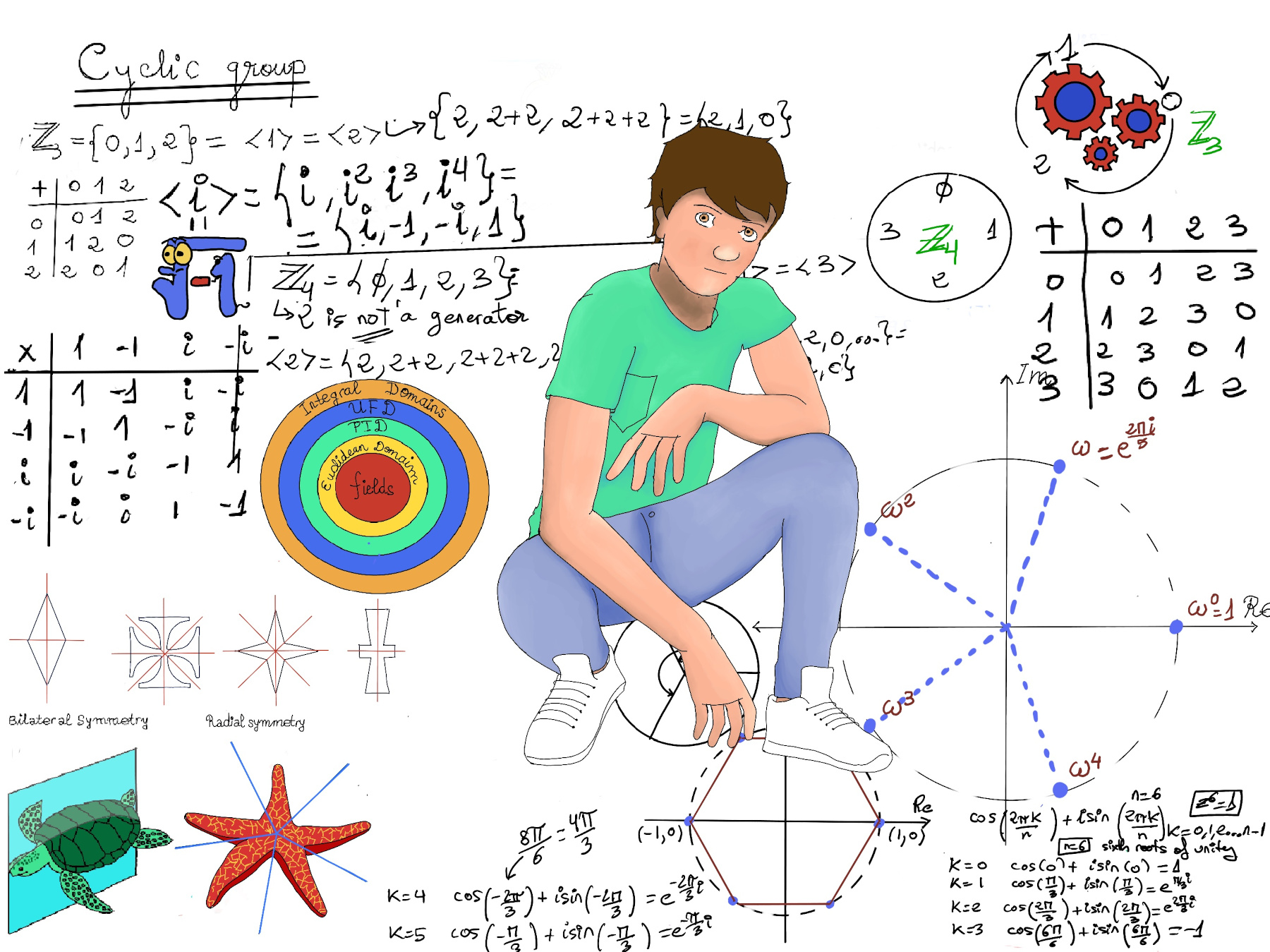
|
 |
 |

|
 |
 |
Don’t worry if people think you’re crazy. You are crazy. You have that kind of intoxicating insanity that lets other people dream outside of the lines and become who they’re destined to be, Jennifer Elisabeth, Born Ready: Unleash Your Inner Dream Girl.

$\int (\frac{1}{x-4} + \frac{2}{x+3})dx = ln|x-4| + 2ln|x+3| + C.$
The cover-up method is a technique used for finding the coefficients in the partial fraction decomposition of a rational function, say $\frac{P(x)}{Q(x)}$. The denominator of the rational function should factor into distinct linear factors and deg(P) < deg(Q).
$\frac{1}{(x-2)(x-3)} = \frac{A}{x-2} + \frac{B}{x-3}$ ⇒[solve for A by multiplying by (x-2)] $\frac{1}{(x-3)} = A + \frac{B(x-2)}{x-3}$ ⇒[set x = 2] $\frac{1}{-1} = A$ ⇒ A = -1. Analogously, [solve for A by multiplying by (x-3)] $\frac{1}{(x-2)} = \frac{A(x-3)}{x-2} + B$ ⇒[set x = 3] B = 1.
$\int \frac{1}{(x-2)(x-3)}dx = -\int \frac{1}{x-2}dx +\int \frac{1}{x-3}dx = -log|x-2| + log|x-3| + C.$
Let’s see a more complicated example when the denominator Q has a repeated linear factor, e.g., $\int \frac{x^2+2}{x^3-3x+2}dx = \int \frac{x^2+2}{(x-1)^2(x+2)}dx$. The partial fraction decomposition is of the form: $\frac{x^2+2}{(x-1)^2(x+2)} = \frac{A}{x-1} + \frac{B}{(x-1)^2} + \frac{C}{x+2}$.
To obtain C, we multiply by (x+2), $\frac{x^2+2}{(x-1)^2} = \frac{A(x+2)}{x-1} + \frac{B(x+2)}{(x-1)^2} + C$, then set x = -2, $\frac{(-2)^2+2}{(-2-1)^2} = C, C = \frac{2}{3}$.
To obtain B, we multiply by (x-1)2, $\frac{x^2+2}{(x+2)} = A(x-1) + B + \frac{C(x-1)^2}{x+2}$, then set x = 1, $\frac{1^2+2}{1+2} = B$ ⇒ B = 1. This method does not work for the constant A.
Finally, we set x = 0, $\frac{2}{(-1)^2·2} = \frac{A}{-1} + \frac{B}{(-1)^2}+\frac{C}{2}$ =[B = 1, C = 2/3] $1 = \frac{A}{-1} + \frac{1}{(-1)^2}+\frac{2/3}{2}$ ⇒ 1 = -A +1 +1/3, A = 1⁄3.
$\int \frac{x^2+2}{x^3-3x+2}dx = \int \frac{x^2+2}{(x-1)^2(x+2)} = \int \frac{1/3}{x-1} +\frac{1}{(x-1)^2} + \frac{2/3}{x+2} dx = \frac{1}{3}ln|x-1| -\frac{1}{x-1} + \frac{2}{3}ln|x+2| + C.$
$\frac{x+1}{(x-1)^3(x-2)}dx = \frac{A}{x-1} + \frac{B}{(x-1)^2} + \frac{C}{(x-1)^3} + \frac{D}{x-2}$ [1]
To obtain C, we multiply by (x-1)3, $\frac{x+1}{(x-2)} = A(x-1)^2 + B(x-1) + C + \frac{D(x-1)^3}{x-2}$, then set x = 1, C = $\frac{1+1}{1-2} = -2.$
To obtain D, we multiply by (x-2), $\frac{x+1}{(x-1)^3} = \frac{A(x-2)}{x-1} + \frac{B(x-2)}{(x-1)^2} + \frac{C(x-2)}{(x-1)^3} + D$, then set x = 2, D = $\frac{2+1}{(2-1)^3}=3$
Finally, combining the terms of [1],
$x +1 = A(x-1)^2(x-2) + B(x-1)(x-2) + C(x-2) +D(x-1)^3 = A(x^3-4x^2 + 5x − 2) + B(x^2 − 3x + 2) + C(x − 2) + D(x^3 − 3x^2 + 3x − 1) = (A + D)x^3 + (−4A + B − 3D)x^2 + (5A − 3B + C + 3D)x − 2A + 2B − 2C − D$,
and obtain the following equations,
A + D = 0 ⇒ A = -D = -3
−4A + B − 3D = 0 ⇒ 12 +B -9 = 0 ⇒ B = -3. \
$\int \frac{x+1}{(x-1)^3(x-2)}dx = \int \frac{-3}{x-1}dx + \int \frac{-3}{(x-1)^2}dx + \int \frac{-2}{(x-1)^3}dx + \int \frac{3}{x-2}dx = -3log|x-1|+\frac{3}{x-1}+\frac{1}{(x-1)^2}+3log|x-2|+C.$
The partial fraction decomposition is of the form: $\frac{x^2}{(x-1)(x^2+1)} = \frac{A}{x-1}+\frac{Bx + C}{x^2 +1}$.
Cover up for A is quite the same process, by multiplying for (x -1), $\frac{x^2}{(x^2+1)} = A +\frac{(Bx + C)(x-1)}{x^2 +1}$, then set x = 1, $\frac{1^2}{1^2+1} = A ⇒ A = \frac{1}{2}.$
Cover up for B and C is done by clearing the denominator, $x^2 = A(x^2+1) + (Bx+C)(x-1) = \frac{1}{2}(x^2+1) + (Bx+C)(x-1)$. x2 term, $1 = \frac{1}{2} + B ⇒ B = \frac{1}{2}$, and the constant term $0 = \frac{1}{2} -C ⇒ C = \frac{1}{2}$.
$\int \frac{x^2}{(x-1)(x^2+1)}dx = \int \frac{\frac{1}{2}}{(x-1)}dx + \int \frac{\frac{x}{2}}{(x^2+1)}dx + \int \frac{\frac{1}{2}}{(x^2+1)}dx= \frac{1}{2}ln|x-1| + \frac{1}{4}ln(x^2+1) + \frac{1}{2}tan^{-1}x + C~ because~ \frac{d}{dx}ln(x^2+1)=\frac{2x}{x^2+1}.$
$\int \frac{x}{(x^2+4)^3}dx$ =[u = x2+4, du = 2xdx] = $\int \frac{1}{2(u)^3}du = \frac{1}{2}\frac{u^{-2}}{-2}+C = \frac{-1}{4}u^{-2}+C = \frac{-1}{4(x^2+4)^2}+C$
An improper rational fraction refers to a rational function where the degree of the numerator is greater than or equal to the degree of the denominator, e.g., $\frac{x^2}{x+1}, \frac{x^3}{(x-1)(x+2)}=\frac{x^3}{x^2+x-2}$.
Let’s apply long division,
$\int \frac{x^2}{x+1} = \int (x-1+\frac{1}{x+1})dx = \frac{1}{2}x^2 -x + log|x+1| + C.$
$\int \frac{x}{x+1}dx$ =[long division] $\int (1-\frac{1}{x+1})dx = x -log|x+1| + C.$
To calculate $\int \frac{x^3}{x^2+x-2}dx$, let’s apply long division,
$\int \frac{x^3}{x^2+x-2}dx = \int x - 1 + \frac{3x -2}{x^2 +x -2} dx$
Let’s factor the denominator x2+x-2 = (x +2)(x -1), $\frac{3x -2}{x^2 +x -2} = \frac{A}{x+2} + \frac{B}{x-1}$. To calculate A and B, we multiply for (x+2) and (x-1) respectively. $\frac{3x -2}{x -1} = A + \frac{B(x+2)}{x-1}$, set x = -2, $\frac{-6-2}{-2-1} = A ⇒ A = \frac{8}{3}$. Similarly, $\frac{3x -2}{x +2} = A\frac{x-1}{x+2} + B$, set x = 1, B = $\frac{3-2}{1+2} = \frac{1}{3}$
$\int \frac{x^3}{x^2+x-2}dx = \int x - 1 + \frac{3x -2}{x^2 +x -2} dx = \int x - 1 + \frac{\frac{8}{3}}{x+2} + \frac{\frac{1}{3}}{x-1} dx = \frac{1}{2}x^2 -x + \frac{8}{3}ln|x+2| +\frac{1}{3}ln|x-1| + C.$